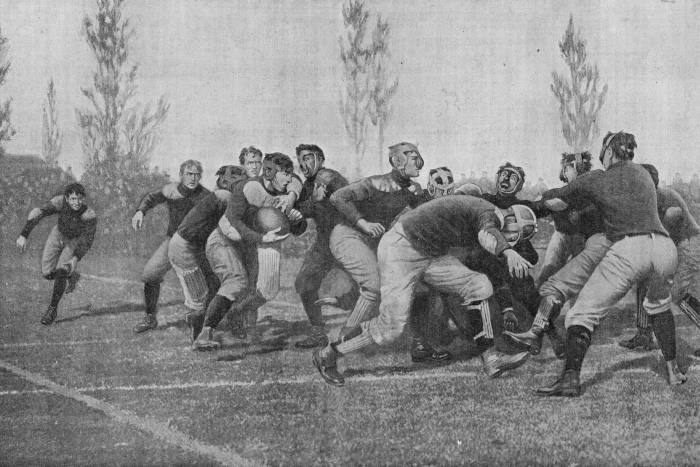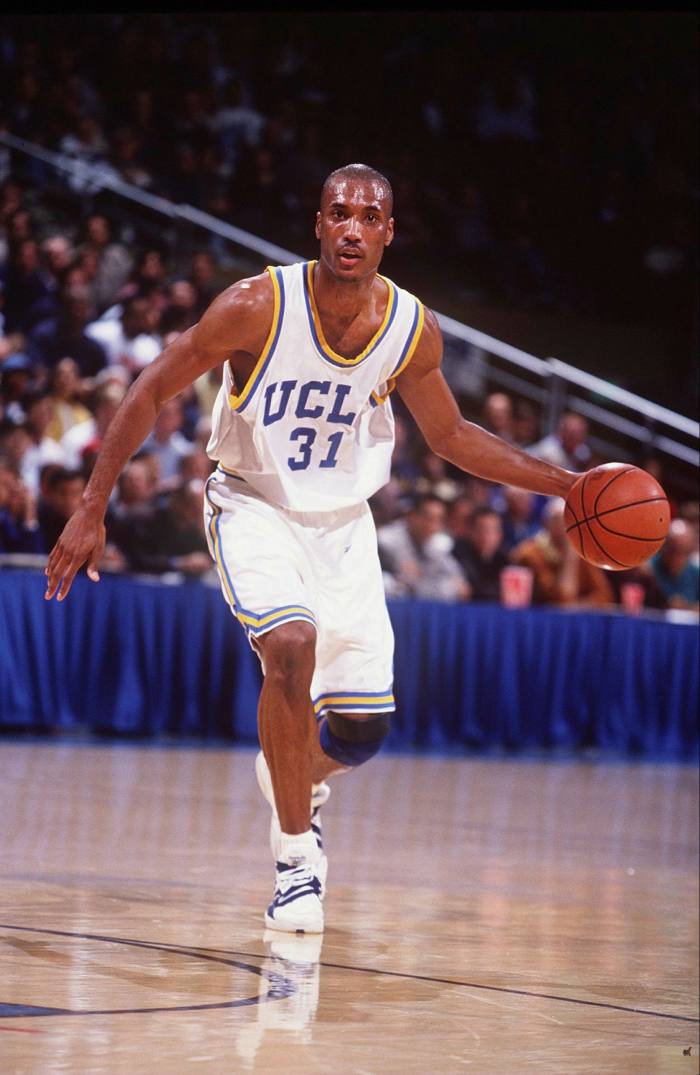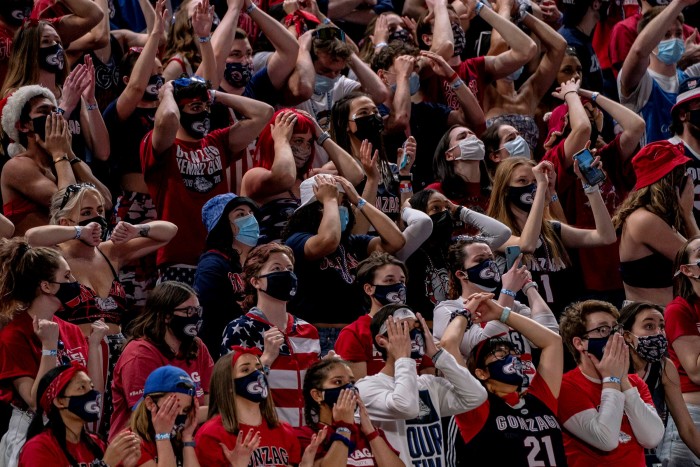In the autumn of 2019, Bo Nix set scoring and passing records as the starting quarterback for Auburn University. He led the American football team to nine wins and helped drive more than $97m in revenues to the prestigious college football programme, but Nix, then 19, earned nothing for his efforts.
For nearly a century, as US college sports ballooned into a more than $14bn industry, student athletes have been forbidden from receiving any pay for their performances or for rights to their name, image, and likeness, or NIL, as the National Collegiate Athletic Association payment policy is known. The governing body has long argued that paying players beyond tuition scholarships would take the emphasis away from education, and make sports for undergraduate university students indistinguishable from professional leagues.
But this year the NCAA, defenders of some of the most steadfast amateurism rules remaining in sport, effectively threw open the floodgates. Under pressure from imminent changes to state laws that from July 1 would have explicitly given student athletes the right to payment, and a landmark Supreme Court ruling which blasted the NCAA’s business model as “flatly illegal”, the Indianapolis-based organisation voted to suspend enforcement of the NIL policy entirely.
The result is a dealmaking free-for-all between college stars such as Nix, who now has his own lawyer to vet deals, sponsors and an emerging cottage industry catering to the new marketplace. Confusion remains, however, as to how a thickening patchwork of state laws and possible federal legislation will regulate this fledgling image rights market for college athletes.

University sports have long been big business: the NCAA oversees more than 500,000 athletes participating in two dozen sports across more than 1,000 universities and colleges throughout the US. Top coaches in basketball and football are among the highest-paid public employees in the country, with annual salaries in the millions. Tens of millions of Americans watched the March Madness student basketball tournament this year, a three-week event worth $1.1bn in annual broadcast revenues alone.
With the college football season just under way, sponsors, lawyers and licensees are now scrambling to make sense of a multibillion dollar industry which professionalised overnight. “It’s only been two months since things changed, so with hundreds of schools and thousands of athletes it’s been really chaotic trying to sort this out,” says Jamie Mottram, chief executive of Breaking T, a licensed sports shirt business.
Mottram says he expects sales of college sports merchandise to eventually rival that of his top two professional sports merchandise categories, the National Football League and Major League Baseball. Other industry experts, including athlete endorsement platform Opendorse, estimate that the market for NCAA athlete sponsorships will reach approximately $1.5bn in its first year alone.
“It’s clear that the status quo in college sports is not going to hold,” says Amy Privette Perko, chief executive of the Knight Commission on Intercollegiate Athletics, an advocacy group which has long argued that athletes should be compensated beyond being given scholarships and having the costs of attending university covered.

But, given the traditions around one of the most treasured facets of American culture, “no one wants to be held responsible for ruining college sports”, says Victoria Jackson, a former college athlete and sports historian at Arizona State University, who is critical of the NCAA for not creating a sensible NIL framework earlier.
“We’re going to see a splintering soon, and I want university leaders to take responsibility and lead the way,” she adds. “College football is a sports entertainment industry and the sport is also essential to the business of higher education for these schools.”
Adopting the ‘sanity code’
The origins of the NCAA date back over a century, to a time when it was common for universities to hire non-students to play American football on their campuses, a practice which made for a brutal, violent game. In 1905, after 18 deaths and more than 100 serious injuries in the previous college football season alone, US president Theodore Roosevelt urged coaches at Harvard, Princeton and Yale to help clean up the sport. The organisation now known as the NCAA was established the following year.
After the second world war, the NCAA adopted its first formal rules for amateurism, dubbed a “sanity code”. It also regulated recruitment and academic standards for athletes. From the 1950s onward, the college sports industry generated lucrative revenues from two main sources: media companies, which paid handsomely for broadcast rights, and sports manufacturers, which competed to kit out entire teams and universities.
“Historically, college sports have been the true essence of sports in America. Everybody by birth is connected to some university or another,” says Sonny Vaccaro, a former executive at Nike and Adidas who is credited with the idea of marrying shoe companies to college sports.

In 1987, he negotiated the first contract to give Nike the rights to outfit every sports team from football to athletics at an entire college, the University of Miami, a deal worth “hundreds of millions of dollars” by his recollection that set a precedent for universities with elite sports programmes.
The combined effect meant that the NCAA, its member universities and their conferences — the regional leagues that schedule games and negotiate media rights — were raking in billions. But the athletes, the stars of the show, earned nothing from these deals.
By 2019, college sports programmes were generating more than $14.4bn in annual revenues, according to the US Department of Education. Such huge sums “have created this debate about where all this money is going and are the athletes’ benefits appropriate compared to the massive amount of revenues coming in? Are the athletes being treated fairly in the system?”, asks Privette Perko, the Knight Commission executive.
The debate has intensified since a 2009 lawsuit by former college basketball star Ed O’Bannon, who sought payment after he discovered his image and likeness were being used in an NCAA-licensed video game more than a decade after he won a championship with UCLA. The case ended in a split verdict in a US appeals court in 2014. A subsequent lawsuit, known as Alston vs NCAA, built on the O’Bannon precedent and was ultimately taken up by the Supreme Court this summer.
The Alston case was not directly concerned with NIL but with a narrow section of the NCAA’s rules which restrict athletes from some education-related benefits, such as paid tutoring and other services. In a 9-0 unanimous ruling, the justices sided with student athletes, who argued that the restrictions on education benefits violated antitrust law. “The NCAA’s business model would be flatly illegal in almost any other industry in America”, Justice Brett Kavanaugh wrote in his judgment which damaged the long-term credibility of the NCAA.

The stinging defeat by the Supreme Court in June coincided with the first state laws enshrining name, image and likeness rights for students, which came into effect on July 1 in Florida and Ohio. Other states such as California have since followed suit, with Gavin Newsom, the state governor, declaring that the move was to end “the unjust power imbalance in college sports”.
Since the NCAA decision, the shape of this nascent commercial marketplace has largely been up to athletes and brands to formulate.
“On June 30, the NCAA was basically like, ‘welp, athletes can commercialise their own NIL now at every state in every school in the country,” says Mottram. “We aren’t sure how that’s going to work but we are going to figure it out.”
The NCAA is lobbying Congress to introduce federal regulation of NIL to supersede differences in existing state laws, such as those in Florida, Ohio and California. It argues that the lack of an overarching national statute will make the marketplace “harmful” for college sports stars.
“I fear that the longer this patchwork of laws becomes rooted in college sports culture and metastasises, the more difficult, if not impossible, it will become to re-establish . . . fair competition and the primacy of the ‘student’ side of the student-athlete,” said NCAA president Mark Emmert in testimony before the House of Representatives on Thursday.
‘Managing for the now’
The timing of the NCAA suspension — in the middle of summer when no college sports were taking place — gave businesses about six weeks to be ready for the autumn football season. Breaking T uses proprietary data to determine which players and teams are sparking demand in real time, perhaps from a huge play or a trending moment on social media — and can produce a licensed T-shirt within 12 to 18 hours.
One of its earliest signings was Nix, who began capitalising on his NIL privileges immediately, with a paid Instagram post for a family sweet tea company in Alabama on July 1. Since then, he’s enlisted Adam Plant, a family friend and lawyer, to manage his dozens of NIL-related requests — most of which he’s turned down due to the time involved and the payment offered.
“You’ve got to manage for the now but also for what’s next,” says Plant. “You don’t want these guys stepping on their upside,” doing deals that might damage their commercial potential should they later join the professional leagues.
Nix is unusual for having a lawyer — most college athletes are brokering their own licensing deals, and 81 per cent of NIL contracts signed so far are valued at less than $100, according to Opendorse. Yet its preliminary estimates suggest that top college athletes could eventually earn up to $6.5m a year in endorsements.
Mottram of Breaking T says that without player unions or player associations to negotiate group licensing deals — typical in professional sports leagues — his firm has had to resort to “sliding into the DMs”, or direct messages, of athletes’ social media profiles after they make a big play.
It means bigger-ticket deals, such as video game licensing, which typically need consent from entire team rosters, are not yet feasible. “Are gamers going to be OK with it if only eight of the top 20 quarterbacks are featured in the game? It’s not going to be a great product,” adds Mottram.
Navigating the ‘wild west’
The bigger question for the college sports industry is whether and when there will be some form of overarching regulation, either by the NCAA or by Congress.
“NIL doesn’t resolve other systemic and structural issues,” says Jackson, at ASU. She argues that college football in particular has already established itself as a mature entertainment industry and its most lucrative programmes should commit to sharing profits with the students who create the multibillion-dollar media content. It is unclear what the NCAA U-turn will mean for college finances as many contracts have years to run.
For years, the NCAA has asked for federal regulation of college sports, including seeking an exemption from antitrust regulation to maintain its authority as a governing body, spending $3.4m on Washington lobbying since 2014, according to OpenSecrets.

Emmert told the US House of Representatives subcommittee hearing that the NCAA is effectively powerless to create a national NIL framework without opening itself up to further litigation from current and former athletes. “It is unsustainable for NCAA rules to be judged as unlawful and subject to recurring lawsuits each time the Association attempts to make a rule change or policy decision,” he said.
However, Jackson argues that the NCAA could do more but are loath to diminish their lucrative business. “Seeking an antitrust exemption is not the answer here because it means gaining an excuse to not have to see the reality of the industry that [college] football has become,” she says.
Federal bills on college sports have made little progress. Initially, legislators awaited clarity from the courts, which the Alston ruling has now given them.
There is little consensus, however, on how to shape legislation now that the NIL restrictions have been set aside, say aides to both Democratic and Republican senators. “The issue is over doing a NIL-focused bill versus a bill that is not,” says one Republican aide in the Senate, pointing to legislation introduced by a Democratic coalition which emphasises the need for universal health and safety rules and benefits such as a medical trust fund for years after graduation.
Democratic aides say they are wary of describing the stalemate on legislation as purely partisan. They believe they have leverage to get expanded healthcare coverage for college athletes the longer that the stalemate continues, because the NCAA and its stakeholders “want this done as soon as possible so that there is that protection against the lawsuits coming through the court system”, says one aide.

Those lawsuits include a class action filed last year in California by current and former college athletes, which has been amended since the NIL policy suspension to seek damages for athletes who were previously barred from NIL payments.
Nevertheless, the legal grey areas created by the NCAA’s decision mean that some sports marketing businesses are being cautious.
“Because [the NCAA] gave no new policy and just suspended a bylaw, there’s room for interpretation,” says Mike Arthur, senior vice-president at Veritone, which licenses broadcast highlights on behalf of sports leagues. “I counselled my team carefully that I don’t want to set a precedent this year. Let someone else take the bloody arrows first, I’d rather have some lessons be learned,” adds Arthur.
Straining for an appropriate metaphor for the current unpredictability of the college sports industry Arthur says, “it’s really turned into the wild west”.
"industry" - Google News
October 03, 2021 at 11:00AM
https://ift.tt/3zZDFYx
Payday for US college athletes rattles $14bn industry - Financial Times
"industry" - Google News
https://ift.tt/2RrQtUH
https://ift.tt/2zJ3SAW
Bagikan Berita Ini














0 Response to "Payday for US college athletes rattles $14bn industry - Financial Times"
Post a Comment